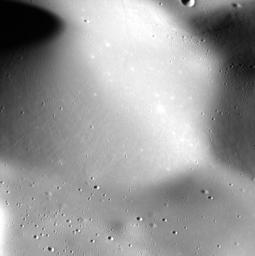
|
Staring at the Sea, Staring at the Sand
- Click the image above for a larger view
- Full-Res JPEG (1020 x 1024) (93.5 kB)
- Full-Res TIFF (1020 x 1024) (1.0 MB)
Caption:
The smooth, rolling terrain in this high resolution image looks almost like sand dunes or ripples on a beach. The smooth texture of this region is due to a blanket of pyroclastic material from the volcanic vent located about 85 km to the south of it. To put the size of this image into perspective, a human could run the length of this image in less than an hour (if they could breathe on Mercury, that is!).
Date acquired:
August 04, 2014
Image Mission Elapsed Time (MET):
49462358
Image ID:
6809127
Instrument:
Narrow Angle Camera (NAC) of the Mercury Dual Imaging System (MDIS)
Center Latitude:
38.03°
Center Longitude:
63.23° E
Resolution:
6 meters/pixel
Scale:
This image is 6.1 km (3.8 mi.) wide.
Incidence Angle:
68.7°
Emission Angle:
29.5°
Phase Angle:
78.3°
Background Info:
The MESSENGER spacecraft is the first ever to orbit the planet Mercury, and the spacecraft's seven scientific instruments and radio science investigation are unraveling the history and evolution of the Solar System's innermost planet. MESSENGER acquired over 150,000 images and extensive other data sets. MESSENGER is capable of continuing orbital operations until early 2015.
For information regarding the use of images, see the MESSENGER image use policy .
Cataloging Keywords:
| Name | Value | Additional Values |
|---|---|---|
| Target | Mercury | |
| System | ||
| Target Type | Planet | |
| Mission | MESSENGER | |
| Instrument Host | MESSENGER | |
| Host Type | Orbiter | |
| Instrument | Mercury Dual Imaging System (MDIS) | |
| Detector | Narrow Angle Camera (NAC) | |
| Extra Keywords | Dune, Grayscale, Radio, Volcano | |
| Acquisition Date | ||
| Release Date | 2014-09-08 | |
| Date in Caption | 2014-08-04 | |
| Image Credit | NASA/Johns Hopkins University Applied Physics Laboratory/Carnegie Institution of Washington | |
| Source | photojournal.jpl.nasa.gov/catalog/PIA18800 | |
| Identifier | PIA18800 | |
